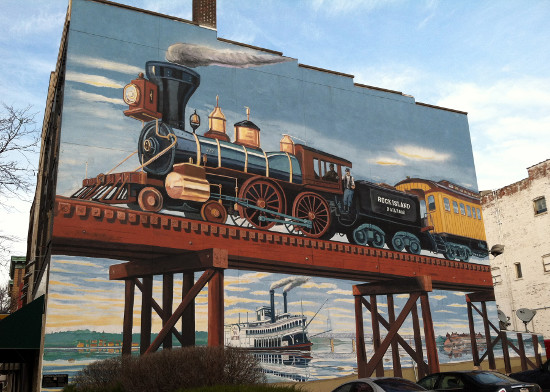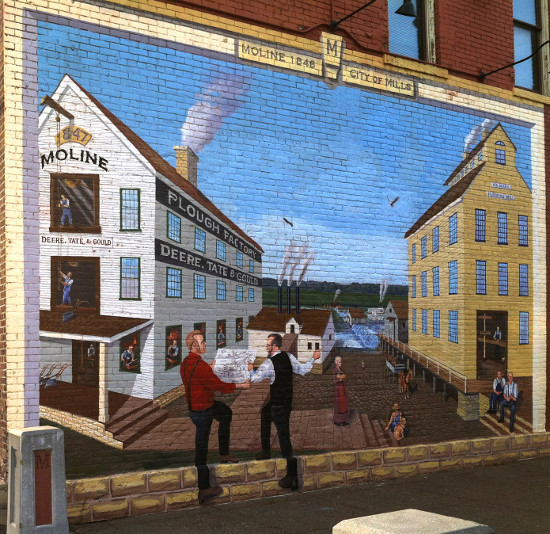
The first railroad bridge across the Mississippi (at Rock Island) and the establishment of industry in Moline are commemorated in two Quad Cities murals painted by William Gustafson. One can almost feel the wheel of progress beginning to turn in the depiction of these transformative events.
The Mighty Fine Line is a 55-by-45-foot mural on the south side of Steve's Old Time Tap in the Rock Island District, near the corner of Third Avenue and 17th Street. Painted in 2006, the mural marks the 150th anniversary of the completion of the first rail bridge to span the Mississippi River. Gustafson, who teaches art at Rock Island High School, worked with Curtis Roseman - a local historian and professor emeritus at the University of Southern California - to provide historic details of the mural's subjects. As Gustafson told me in an interview, historic accuracy in these works was important to him.
The mural is dominated by a life-sized steam locomotive placed high over our heads on a wooden trestle. Beneath the bridge is an approaching steamboat, the Effie Afton - which struck the bridge only 15 days after its completion. The steamboat was destroyed, and it would take four months to repair the damage to the bridge. The placement of the steamboat - like a troll lurking under a bridge - seems to foreshadow the incident.

Three years later, Gustafson completed another mural, City of Mills, located on the east wall in Moline's Historic Block Courtyard at 310 15th Street. The 30-by-18-foot mural shows the riverfront's early industries in the city's founding year of 1848. The Deere, Tate, & Gould Plough Factory and the Sears flour mill frame the background - with their converging diagonals creating an illusion of depth.
In the foreground stand life-sized representations of John Deere (holding a plan for the city) and his partner, John Gould. Painted to appear as if they are standing in front of the mural's frame, these two figures invite us to enter the artwork.
The artist's composition and painting style are suited to the subject. In its straightforward portrayal and robust optimism, it resembles mid-19th Century American painting - the time period depicted in the mural. The positioning of the central figures can be also found in American colonial art. In one late-18th Century painting by Ralph Earl, the master of an estate stands in the foreground looking toward us and gesturing back at his land - similar in spirit to Deere and Gould in this mural.
Gustafson worked with another local historian, Neil Dahlstrom, on City of Mills. Yet the composition isn't limited to a few source photographs or historic facts. The mural is enlivened with detail - including a cat playing with a mouse and the inclusion of a dozen figures seen working in the factory's windows and doorways or the open central area.
Black Hawk is - rightfully - the subject of many of the public artworks in the Illinois Quad Cities. Gustafson's murals, however, tell the story of the next chapter of local history: the rise of industry. These two chapters are surprisingly close; the Deere plow was invented in 1837, only five years after the Black Hawk War.
1837 was also the year that a young lieutenant, Robert E. Lee, spent a summer at the Rock Island Arsenal creating a topographical survey of the Mississippi River around the island. The plans for the first train bridge drew upon his survey.
The accident that damaged the bridge was brought to federal circuit court in 1857, with Abraham Lincoln representing the railroad's interests in the lawsuit. The litigation attracted national attention and proved to be the most notable of Lincoln's court cases - solidifying his reputation as a prominent trial lawyer. As John W. Starr, author of Lincoln & the Railroads, stated: "Lincoln's rise [in politics] was coincident with that of the railroads." Four years after this case, he became the 16th president.
Bruce Walters is a professor of art at Western Illinois University.
This is part of an occasional series on the history of public art in the Quad Cities. If there's a piece of public art that you'd like to learn more about, e-mail the location and a brief description to BD-Walters@wiu.edu.










